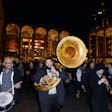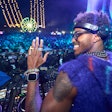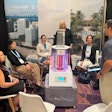The pool parties, which draw thousands each summer, regularly fill up. What does that say about what people are looking for from events?
Kane: People are looking for unique, inclusive experiences at events.
Small: They are looking for a party, a good time, and something to actually do—what we do is not just throw a concert, but we open a park for five hours a day. We offer quality live music, but we also have dodgeball and slip 'n' slide.
Kane: There were more sponsors on board, which helped keep everything free. Last summer we took donations at the door, and this year we’re not doing that. We pride ourselves on being the Robin Hoods of the industry. We like taking big corporate dollars and putting them to good use.
Small: The level of ease at gaining talent at the pool was so much easier, starting the end of last summer, when bands were requesting to be with us. That was a huge change.
And what about next year?
Kane: More of the same, but with some twists and turns. Definitely a few more water elements.
How did the sponsors change the vibe?
Small: We don’t have a lot of banners. We’re lucky that our sponsors want to be part of [the event], more organic.
Kane: We found sponsors that don’t want to own it. We make it clear that they are going to get a lot more of a ripple effect if they integrate into the experience instead of banging people over the head.
How do the sponsors react?
Kane: We know our demographic, and it’s a very hot target group. At the same time, this demographic—the young artist/musician—gets very sketched out when it comes to over-the-top branding. The sponsors are receptive to us telling them that they don’t want to hit people over the head because they’ll lose their audience and the potential new consumers.
Did you turn away sponsors who wanted the traditional presence?
Both: Yes!
Kane: There were sponsors we didn’t go to and who came to us, and they expected to come at it from a different approach.
Small: We have a very serious responsibility to our community. If we go over the top, they will backlash. And we are them, so we know what they want. And they let us know.
Yeah, there’s some angry words on blogs about people getting turned away.
Kane: We don’t actually read [blogs] anymore. We’ve figured out that it’s probably a group of 10 people. People don’t get in. It’s a capacity issue. I can’t stop people from closing gates.
Yet you responded with a letter.
Kane: We don’t know if that was good idea or a bad idea. We have a storefront in Williamsburg. We’re not in some offices where no one can see us.
Small: All those people who blog have the opportunity to come by our store.
Kane: And no one has.
How does the free factor change the events?
Kane: I grew up in Manhattan, and I’ve been to so many events where there’s a specific crowd because those are the people who can afford to be there. Yet the people who are the biggest fans can’t be there. We are those big fans and want those people at our events.
Small: It changes the demographic and it changes the scene.
What’s been the biggest production challenge?
Small: The biggest production challenge is taking a 50,000-square-foot concrete pool and utilizing it during the summer. It gets real hot. We know that because we are out there at 7 a.m. every day. But how do you stop the people from feeling the heat? We do that not only with slip 'n' slide and misting tents, but we try to keep them distracted so people don’t all of a sudden realize they are standing in a reflecting concrete pool.
How was it to work with the city?
Small: I’ve done a lot of cultural events in a lot of parks. You just need to be patient and pay attention to what the community actually wants. The city has a ton of bureaucracy they need to work through to get you what you need.
What’s your take on the Hampton Social series, where tickets start at $3,000 each?
Kane: There are always those people who want über-exclusive events. But we’re getting those people, too, now. These cats I know who spend every weekend in the Hamptons and a few years back wouldn’t even think about coming out to Brooklyn—we’re getting them at the pool.
Small: The Hampton Social set out with a specific goal for their community, and in their own way, they did it. It’s just a different community.
What do you see as the future of events?
Small: There are so many events and so many companies who want to do events and so many marketing dollars being spent. Companies and sponsors are starting to see that if they’re not really strategic about how to spend money, they’re wasting their time. It’s about creating experience and it’s about really creating atmosphere—a quality control that hasn’t existed because people are wilding out.



















